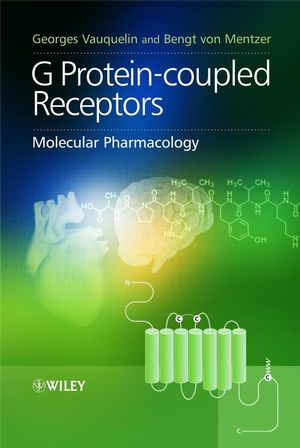G Protein-coupled Receptors: Molecular PharmacologyISBN: 978-0-470-51647-8
Hardcover
264 pages
November 2007
 Other Available Formats: E-book
|
||||||
FOREWORD.
1. CHEMICAL MESSENGERS AND THE CELL MEMBRANE.
1.1. Endocrine signalling by hormones.
1.2. The nervous system and synaptic signalling by neurotransmitters.
SMALL MOLECULE NEUROTRANSMITTERS.
NEUROPEPTIDES.
1.3. Paracrine signalling by local chemical messengers.
1.4. Hydrophobicity: effect on release and transport of messengers.
1.5. Membrane proteins and membrane receptors.
1.6. Ligand receptor interactions.
2. RADIOLIGAND BINDING STUDIES
2.1. Technical aspects of radioligand binding.
2.2. Saturation binding.
2.3. Competition binding.
2.4 Kinetic experiments.
2.5. Regional distribution of receptors.
3. FUNCTIONAL STUDIES
3.1. Dose-response curves and associated problems.
3.2. From receptor-occupation to stimulus and response.
FROM RECEPTOR OCCUPATION TO STIMULUS.
FROM STIMULUS TO RESPONSE : LINEAR RELATIONSHIP.
FROM STIMULUS TO RESPONSE: NON-LINEAR RELATIONSHIP.
3.3. Receptor classification and antagonist affinity.
3.4. Pharmacological models.
4. G PROTEIN-COUPLED RECEPTORS
4.1. From receptor to response: introduction to GPCRs.
4.2. GPCR structure.
4.3. Ligand interaction with family A, B, C receptors.
LIGAND INTERACTION WITH FAMILY A RECEPTORS.
LIGAND INTERACTION WITH FAMILY B RECEPTORS.
LIGAND INTERACTION WITH FAMILY C RECEPTORS.
4.4. Receptor activation.
4.5. Activated GPCRs: interaction with G proteins.
TECHNIQUES TO STUDY G -PROTEIN COUPLING PREFERENCE.
DIVERGENCE OF INTRACELLULAR SIGNALLING.
4.6. Activated GPCRs: phosphorylation and internalisation.
RECEPTOR PHOSPHORYLATION.
b-ARRESTIN BINDING MEDIATE GPCR ENDOCYTOSIS.
MECHANISMS TO TERMINATE SIGNALLING.
4.7. b-Arrestin- binding and MAP kinase activation.
4.8. GPCR dimerisation and association with other proteins.
INTRODUCTORY COMMENTS.
GPCR DIMERISATION.
GPCR INTERACTION WITH OTHER MEMBRANE RECEPTORS.
GPCR INTERACTION WITH OTHER MEMBRANE PROTEINS.
GPCR INTERACTION WITH CYTOPLASMIC PROTEINS.
4.9. Early models for GPCR activation.
4.10. Restricted GPCR mobility and G protein coupling.
MEMBRANE COMPARTIMENTALISATION.
RESTRICTED GPCR- G PROTEIN COUPLING: EFFECTOR ACTIVITY.
4.11. Spontaneous receptor- G protein coupling.
MODELS.
INVERSE AGONISM.
4.12. Interaction of two G proteins with one activated receptor state.
FUSION PROTEINS BETWEEN GPCRS AND G PROTEINS
4.13. Multiple receptor conformations.
“AGONIST TRAFFICKING”: WHAT DO MODELS PREDICT?
EXPERIMENTAL “EVIDENCE” FOR AGONIST TRAFFICKING: POTENTIAL PITFALLS.
MULTISTATE RECEPTORS: LIGAND- MEDIATED SEQUENTIAL CHANGES IN RECEPTOR CONFORMATION.
MULTIPLE RECEPTOR STATES RELATED TO TRUNCATION, COVALENT MODIFICATION AND MUTATION.
4.14. Multistate receptors and multiple ligand binding sites.
THE GENERAL ALLOSTERIC TERNARY COMPLEX MODEL.
EXOGENOUS AND ENDOGENOUS ALLOSTERIC MODULATORS.
ALLOSTERIC PHENOMENA AT GPCR: DETECTION BY RADIOLIGAND BINDING.
DETECTION OF ALLOSTERIC PHENOMENA AT GPCR BY FUNCTIONAL ASSAYS.
USEFULNESS OF ALLOSTERIC MODULATORS.
4.15. "Competitive", "non-competitive "and "insurmountable" antagonism.
CO-INCUBATION, NO RECEPTOR RESERVE.
ANTAGONIST PREINCUBATION, NO RECEPTOR RESERVE.
4.16. Naturally occurring mutations of GPCRs.
5. CONCLUDING REMARKS.
REFERENCES.
INDEX.



